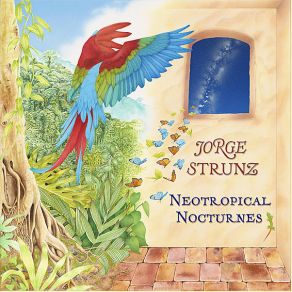Neotropical Nocturnes
Download links and information about Neotropical Nocturnes by Jorge Strunz. This album was released in 2010 and it belongs to Jazz, World Music genres. It contains 10 tracks with total duration of 47:01 minutes.

|
|
|---|---|
| Artist: | Jorge Strunz |
| Release date: | 2010 |
| Genre: | Jazz, World Music |
| Tracks: | 10 |
| Duration: | 47:01 |
| Buy it NOW at: | |
| Buy on iTunes $9.90 | |
| Buy on Amazon $8.99 | |
Tracks
[Edit]| No. | Title | Length |
|---|---|---|
| 1. | Tocar la Noche (Play the Night) | 4:42 |
| 2. | Velvet Midnight | 5:44 |
| 3. | De Alicia | 5:14 |
| 4. | Idilios (Idylls) | 5:53 |
| 5. | Teatro del Tiempo (Theater of Time) | 4:35 |
| 6. | La Finca (The Farm) | 3:50 |
| 7. | Zambriya | 4:28 |
| 8. | Cielo Playero (Coastal Sky) | 4:19 |
| 9. | Los Temporales (Rainstorms) | 4:35 |
| 10. | Cadenitas (Little Chains) | 3:41 |
Details
[Edit]For many years, instrumentalist Jorge Strunz has had a very multicultural outlook. That was evident when he was with the late '70s jazz-fusion band Caldera, and it was equally evident on the '80s, '90s, and 2000s albums that the Costa Rica native recorded with Iranian guitarist Ardeshir Farah as half of the acoustic guitar duo Strunz & Farah. Thankfully, Strunz's multiculturalism doesn't decrease a bit on his solo album Neotropical Nocturnes, which isn't a radical departure from Strunz & Farah's output. Strunz brings so many different influences to this 2010 release (Hispanic as well as Mediterranean, Middle Eastern, and North African) that categorization is difficult. Perhaps the most convenient description of Neotropical Nocturnes would be nuevo flamenco. Certainly, Spanish flamenco guitar is a prominent influence on this 47-minute recording, but Strunz is by no means a flamenco purist — and he never claimed to be. In fact, the term "nuevo flamenco" implies that one isn't getting traditional flamenco, but rather, a hybrid mixture of flamenco and other styles. There are many influences on Neotropical Nocturnes other than flamenco, including Colombian cumbia on "La Finca," Peruvian landó on "Cielo Playero," and Afro-Cuban music on "La Finca." Meanwhile, "Zambraya" draws on both flamenco and Arabic music, which makes sense because flamenco's Moorish heritage is still evident after all these years. But despite having all those different influences, Neotropical Nocturnes never sounds confused or unfocused. Strunz is an expert when it comes to bringing a variety of influences together and making things sound totally organic rather than forced or unnatural. Those who admired Strunz' work with Ardeshir Farah will be glad to know that his multicultural perspective serves him equally well on Neotropical Nocturnes.